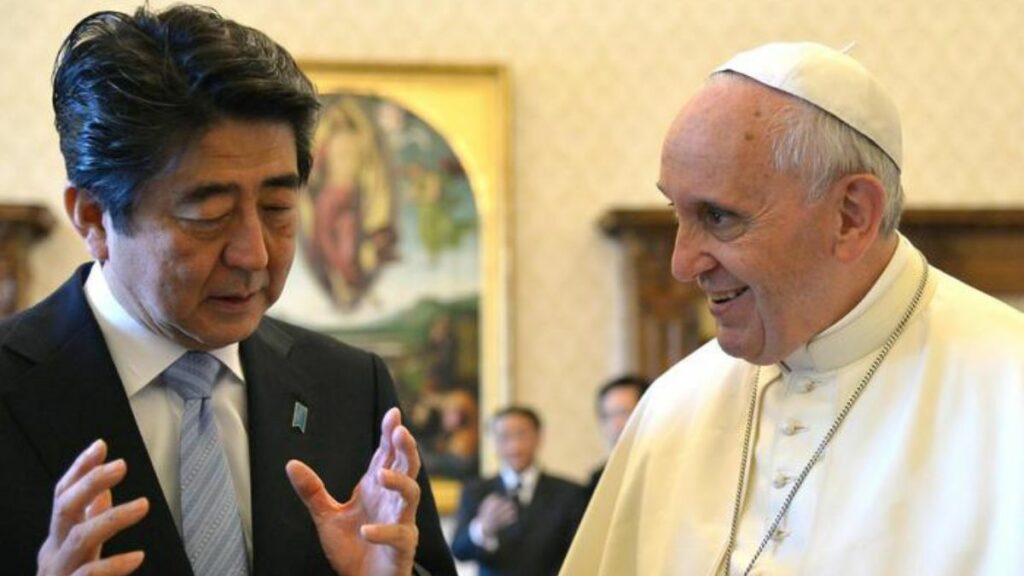Former Japanese Prime Minister Shinzo Abe, who was assassinated on July 8 in Nara, is in fact called Abe Shinzo. Because the Japanese (as well as the Chinese and Koreans) write their last name first, and then their first name. In May 2019, Tokyo officially asked Western media to scrupulously observe this traditional protocol, in defiance of even the Chicago Manual of Style, but the plea basically fell on deaf ears.
On June 6, 2014 (coincidentally the anniversary of the Normandy landings, not exactly fresh water for either the West or Japan) Abe visited Pope Francis at the Vatican. At the traditional and highly symbolic gift exchange, the then prime minister of the Land of the Rising Sun gave the pontiff a mirror. Trivial, apparently. Tilted with some care until it intercepted a ray of the Sun, the mirror indeed revealed “magic”: the face of Christ and a Cross in transparency.
Triumph of pandering kitsch? Not at all. The mirror was in fact a modern replica, made by a Japanese craftsman for the Pope at Abe’s explicit request, of an ancient and valuable artifact. The mirror in front of which kakure kirishitan, the “hidden” Christians of Japan, used to pray clandestinely during one of the cruelest anti-Catholic persecutions history has ever known.
Having landed in Japan on August 15, 1549, thanks to St. Francis Xavier (1506-1552), Christianity found a rigidly caste-ridden country, lacking any real central authority, torn apart by infighting and in fact led by the shōgun, the commander of the imperial army. The new faith spread rapidly and by the turn of the 16th and 17th centuries had about 300,000 souls. Its heart was the city of Nagasaki.
The fear of competition that certain Shintoists and Buddhists had, plus the fear of intelligence with foreign powers nurtured with genuine conspiracy phobia by political power, soon turned initial favor into open hostility. On July 24, 1587, Toyotomi Hideyoshi (1537-1598), regarded as the second “Great Unifier” of Japan, banned European missionaries and on February 5, 1597, he went rogue, crucifying 26 kirishitan (six Franciscans, three Japanese Jesuits and 17 Japanese Franciscan tertiaries). Upon the tyrant’s death the persecution subsided somewhat, but soon resumed new vigor with the shōgun Tokugawa Ieyasu(1543-1616). In 1614 all public profession of the Catholic faith was banned, missionaries were expelled again, and the burning of those who remained, nailed to crosses raised for all to see, lit up the nights of Nagasaki.
“Hidden” Christians then came to be concentrated on the Shimabara Peninsula, 70 kilometers south of Nagasaki. There, by 1577, the entire population had converted, including the daimyō, or local lord. On the day of the Solemnity of the Ascension, the revolt against the central power, led by Catholic samurai, broke out. The confrontation was bitter, epic; the outcome a carnage. The bodies of the rioters were battered and torn apart, the shōgun lost 70,000 samurai. Not even the legendary Miyamoto Musashi (1584-1645), the most famous samurai ever, could do anything against the troops of the 16-year-old leader of the “crusade,” Masuda Shirō Tokisada (1621-1638), known as Amakusa Shirō. Only hunger and hardship were the reason.
After the Shimabara revolt, the shōgun declared the Sakoku, hermetically sealing Japan to all foreigners. It took U.S. gunboats to reopen it, two and a half centuries later.
Also belonging to this era is the epic of the great Takayama Ukon (1552?-1615), noble warrior son of noble warrior, Christian samurai by the name of Justo, son of Christian samurai by the name of Darius. They became daimyō of Takatuski Castle in Osaka Prefecture and ruled as good kirishitan, but persecution hit them hard. On November 8, 1614, after the decree expelling Christian missionaries from Japan, Christ’s samurai left the country with 300 comrades from the very Catholic Nagasaki. On December 21 they arrived in Manila, Philippines, triumphantly welcomed by Jesuits who had come from Spain, and whose crown was immediately proposed to Ukon to overthrow the shōgun. But the daimyō was a man of honor. He refused and 40 days later, on February 5, 1615, he died of illness. On February 7, 2017, Pope Francis beatified him, a father of the second evangelization of the Philippines.
Japanese Catholic novelist Endō Shūsaku (1923-1996) based his own masterpiece, Silence(沈黙), published in 1966, on this story, both heroic and saddening. The novel was later adapted into three films: the first, with an identical title to the book, directed by Shinoda Masahiro in 1971; the second, the subject of controversy, directed by Martin Scorsese, also with the same title, in 2016; and the third, in between, released in 1996 with the title Os Olhos da Ásia (“The Eyes of Asia”), directed by Portuguese João Mário Lourenço Bagão Grilo.
Now, the “magic” mirror that in 2014 the late Abe Shinzo gave as a gift to the same Catholic pope who in 2017 would exalt Christ’s samurai to the glory of the altars tells a great story of religious persecution and the struggle for basic freedoms. One can only imagine the courage of that Japanese patriot who found a way to publicly repent the misdeeds of his ancestors before the Pontiff without losing his own honor and that of his great country.
